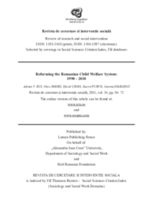Abstract
The Romanian child welfare system has undergone a series of major changes over the past two decades, impacting the type of care and developmental outcomes for Romanian orphans and foster children. Each distinct reform period within this twenty-year span can be identified by the laws and governmental reform measures enacted, the shift in child population among various Romanian institutions and foster care homes, types of institutions available to children, level of care, shift in reasons for child abandonment, changes in ways children are routed through the system, and how these changes have effect children’s development, health, and psychological well-being.

